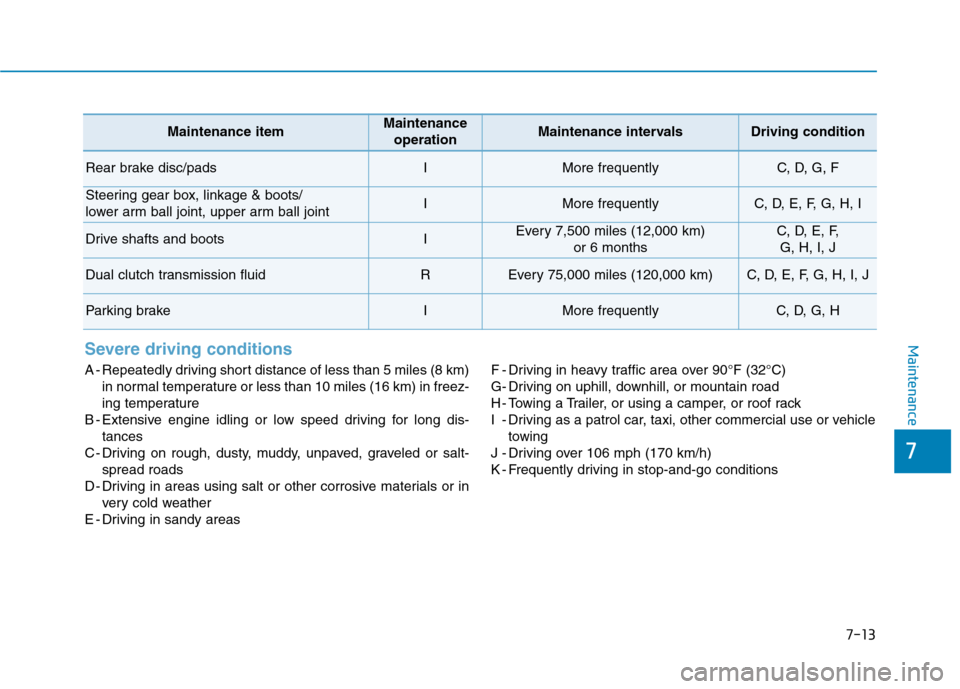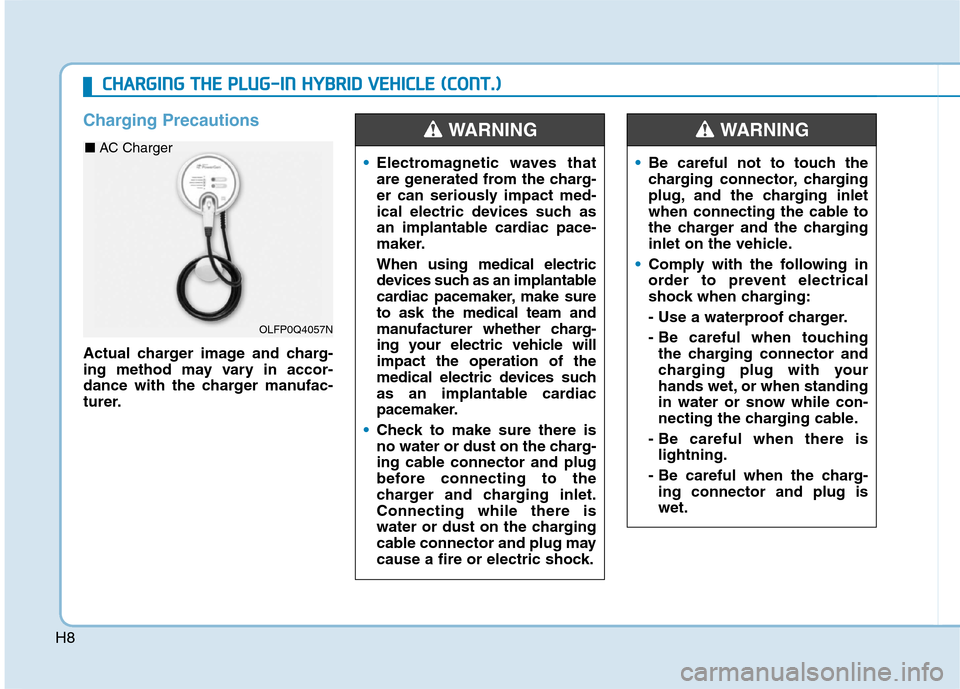2020 Hyundai Ioniq Hybrid roof
[x] Cancel search: roofPage 442 of 635

6-6
What to do in an emergency
The following items may need to be
reset after the battery has been dis-
charged or the battery has been dis-
connected. See chapter 3 or 4 for:
Power Windows
Trip Computer
Climate Control System
Clock
Audio System
Sunroof
Driver Position Memory System
External power source using 12V
battery
The use of external power acces-
sories may reduce performance
and function of the vehicle.
Especially, the use of dash cam-
eras may shut off the power of the
vehicle prior to the dash camera's
automatic shut-down.
If the power of the vehicle is shut
off, start the vehicle as explained.
(refer to "Using the 12V Battery
Switch")
Jump Starting
In the event vehicle still does not
have a functional 12V battery (check
if interior lights will not turn on) then
you can try a jump start to the engine
compartment jumper terminals using
a 12V booster pack or jumper cables
from another vehicle's 12V battery
according to the following instruc-
tions.1. Position the vehicles close enough
that the jumper cables will reach,
but do not allow the vehicles to
touch.
2. Avoid fans or any moving parts in
the engine compartment at all
times, even when the vehicles are
turned off.
3. Turn off all electrical devices such
as radios, lights, air conditioning,
etc. Put the vehicles in P (Park)
and set the parking brake. Turn
both vehicles OFF.
NOTICEJump starting can be danger-
ous if done incorrectly. Follow
the jump starting procedure in
this section to avoid serious
injury or damage to your vehi-
cle. If in doubt about how to
properly jump start your vehi-
cle, we strongly recommend
that you have a service techni-
cian or towing service do it for
you.
CAUTION
Page 493 of 635

7-13
7
MaintenanceSevere driving conditions
A - Repeatedly driving short distance of less than 5 miles (8 km)
in normal temperature or less than 10 miles (16 km) in freez-
ing temperature
B - Extensive engine idling or low speed driving for long dis-
tances
C - Driving on rough, dusty, muddy, unpaved, graveled or salt-
spread roads
D - Driving in areas using salt or other corrosive materials or in
very cold weather
E - Driving in sandy areasF - Driving in heavy traffic area over 90°F (32°C)
G- Driving on uphill, downhill, or mountain road
H - Towing a Trailer, or using a camper, or roof rack
I - Driving as a patrol car, taxi, other commercial use or vehicle
towing
J - Driving over 106 mph (170 km/h)
K - Frequently driving in stop-and-go conditions
Maintenance itemMaintenance
operationMaintenance intervalsDriving condition
Rear brake disc/padsIMore frequentlyC, D, G, F
Steering gear box, linkage & boots/
lower arm ball joint, upper arm ball jointIMore frequentlyC, D, E, F, G, H, I
Drive shafts and bootsIEvery 7,500 miles (12,000 km)
or 6 monthsC, D, E, F,
G, H, I, J
Dual clutch transmission fluidREvery 75,000 miles (120,000 km)C, D, E, F, G, H, I, J
Parking brakeIMore frequentlyC, D, G, H
Page 513 of 635

By jump starting
After a jump start from a good bat-
tery, drive the vehicle for 20-30 min-
utes before it is shutoff. The vehicle
may not restart if you shut it off
before the battery had a chance to
adequately recharge. See "Jump
Starting" in chapter 6 for more infor-
mation on jump starting procedures.
Information
An inappropriately disposed
battery can be harmful to
the environment and human
health. Dispose of the bat-
tery according to your local
law(s) or regulations.
Reset Features
The following items may need to be
reset after the battery has been dis-
charged or the battery has been dis-
connected. See chapter 3 or 4 for:
Power Windows
Trip Computer
Climate Control System
Clock
Audio System
Sunroof
Driver Position Memory System
i
7-33
7
Maintenance
(Continued)
Watch the battery during
charging, and stop or reduce
the charging rate if the battery
cells begin boiling violently.
The negative battery cable
must be removed first and
installed last when the battery
is disconnected. Disconnect
the battery charger in the fol-
lowing order:
(1) Turn off the battery charg-
er main switch.
(2) Unhook the negative
clamp from the negative
battery terminal.
(3) Unhook the positive clamp
from the positive battery
terminal.
Always use a genuine
HYUNDAI approved battery
when you replace the battery.
Page 525 of 635

7-45
7
Maintenance
Kilopascal (kPa)
The metric unit for air pressure.
Light truck(LT) tire
A tire designated by its manufacturer
as primarily intended for use on light-
weight trucks or multipurpose pas-
senger vehicles.
Load ratings
The maximum load that a tire is rated
to carry for a given inflation pressure.
Load Index
An assigned number ranging from 1
to 279 that corresponds to the load
carrying capacity of a tire.
Maximum Inflation Pressure
The maximum air pressure to which
a cold tire may be inflated. The max-
imum air pressure is molded onto the
sidewall.
Maximum Load Rating
The load rating for a tire at the maxi-
mum permissible inflation pressure
for that tire.
Maximum Loaded Vehicle
Weight
The sum of curb weight; accessory
weight; vehicle capacity weight; and
production options weight.
Normal Occupant Weight
The number of occupants a vehicle
is designed to seat multiplied by 150
pounds (68 kg).
Occupant Distribution
Designated seating positions.
Outward Facing Sidewall
An asymmetrical tire has a particular
side that faces outward when mount-
ed on a vehicle. The outward facing
sidewall bears white lettering or
bears manufacturer, brand, and/or
model name molding that is higher or
deeper than the same moldings on
the inner facing sidewall.
Passenger (P-Metric) tire
A tire used on passenger cars and
some light duty trucks and multipur-
pose vehicles.
Ply
A layer of rubber-coated parallel
cords.
Pneumatic tire
A mechanical device made of rubber,
chemicals, fabric and steel or other
materials, that, when mounted on an
automotive wheel provides the trac-
tion and contains the gas or fluid that
sustains the load.
Pneumatic options weight
The combined weight of installed
regular production options weighing
over 5 lb. (2.3 kg) in excess of the
standard items which they replace,
not previously considered in curb
weight or accessory weight, includ-
ing heavy duty breaks, ride levelers,
roof rack, heavy duty battery, and
special trim.
Page 579 of 635

H8
C CH
HA
AR
RG
GI
IN
NG
G
T
TH
HE
E
P
PL
LU
UG
G-
-I
IN
N
H
HY
YB
BR
RI
ID
D
V
VE
EH
HI
IC
CL
LE
E
(
(C
CO
ON
NT
T.
.)
)
Charging Precautions
Actual charger image and charg-
ing method may vary in accor-
dance with the charger manufac-
turer.Electromagnetic waves that
are generated from the charg-
er can seriously impact med-
ical electric devices such as
an implantable cardiac pace-
maker.
When using medical electric
devices such as an implantable
cardiac pacemaker, make sure
to ask the medical team and
manufacturer whether charg-
ing your electric vehicle will
impact the operation of the
medical electric devices such
as an implantable cardiac
pacemaker.
Check to make sure there is
no water or dust on the charg-
ing cable connector and plug
before connecting to the
charger and charging inlet.
Connecting while there is
water or dust on the charging
cable connector and plug may
cause a fire or electric shock.
WARNING
Be careful not to touch the
charging connector, charging
plug, and the charging inlet
when connecting the cable to
the charger and the charging
inlet on the vehicle.
Comply with the following in
order to prevent electrical
shock when charging:
- Use a waterproof charger.
- Be careful when touching
the charging connector and
charging plug with your
hands wet, or when standing
in water or snow while con-
necting the charging cable.
- Be careful when there is
lightning.
- Be careful when the charg-
ing connector and plug is
wet.
WARNING
OLFP0Q4057N
■ AC Charger
Page 629 of 635

I-3
California perchlorate notice ..........................................7-79
Child Restraint System (CRS) ........................................2-36
Children Always in the Rear ......................................2-36
Installing a Child Restraint System (CRS) ................2-39
Selecting a Child Restraint System (CRS).................2-37
Climate control additional features...............................3-159
Automatic Ventilation .............................................3-159
Sunroof inside air recirculation ................................3-159
Climate control air filter .................................................7-26
Filter inspection ..........................................................7-26
Coasting guide ...............................................................5-25
Consumer information ....................................................8-11
Cruise control ...............................................................5-107
Cruise Control operation ..........................................5-107
Dimensions .......................................................................8-2
Door locks .........................................................................3-9
Auto Door Lock/Unlock Features ..............................3-12
Child-Protector Rear Door Locks ..............................3-12
Operating Door Locks from Inside the Vehicle ........3-10
Operating Door Locks from Outside the Vehicle .......3-9
Driver Attention Warning (DAW) ..................................5-99
Leading Vehicle Departure Alert .............................5-105
Resetting the system ................................................5-102System malfunction ..................................................5-102
System setting and operation .....................................5-99
System standby.........................................................5-102
Driver position memory system ....................................3-14
Easy Access Function .................................................3-15
Recalling Positions from Memory .............................3-15
Storing Positions into Memory .................................3-14
Dual clutch transmission.................................................5-12
Dual Clutch Transmission Operation .........................5-12
Good Driving Practices .............................................5-20
LCD display for transmission temperature and
warning message ......................................................5-14
Parking........................................................................5-19
Shift Lever Position....................................................5-16
Emission control system .................................................7-75
Crankcase Emission Control System .........................7-76
Evaporative Emission Control System Including
Onboard Refueling Vapor Recovery (ORVR) .........7-76
Exhaust Emission Control System .............................7-76
Engine ...............................................................................8-2
Engine compartment .........................................................7-3
Engine coolant/inverter coolant ......................................7-18
Changing Coolant.......................................................7-21
Checking the Coolant Level .......................................7-18
Engine number ................................................................8-10
I
Index
C
D
E
Page 633 of 635

I-7
Scheduled maintenance services.......................................7-8
Maintenance Under Severe Usage Conditions...........7-12
Normal Maintenance Schedule ....................................7-9
Severe driving conditions ...........................................7-13
Seat belts .........................................................................2-23
Additional Seat Belt Safety Precautions ....................2-32
Care of Seat Belts .......................................................2-35
Seat Belt Restraint System .........................................2-25
Seat Belt Safety Precautions ......................................2-23
Seat Belt Warning Light .............................................2-24
Seats ..................................................................................2-4
Battery Cooling Duct .................................................2-22
Front Seats ....................................................................2-6
Head Restraints ..........................................................2-16
Rear Seats ...................................................................2-12
Safety Precautions ........................................................2-5
Seat warmers ..............................................................2-20
Smart cruise control .....................................................5-112
Limitations of the system .........................................5-125
Sensor to detect distance to the vehicle ahead .........5-123
Smart Cruise Control speed......................................5-115
Smart Cruise Control Vehicle-to-Vehicle Distance ..5-120
To adjust the sensitivity of Smart cruise control......5-114
To convert to Cruise Control mode ..........................5-114Special driving conditions ............................................5-158
Driving at Night .......................................................5-159
Driving in Flooded Areas .........................................5-160
Driving in the Rain ...................................................5-159
Hazardous Driving Conditions .................................5-158
Highway Driving ......................................................5-160
Rocking the Vehicle ..............................................5-158
Smooth Cornering ....................................................5-159
Steering wheel.................................................................3-16
Electric Power Steering (EPS) ...................................3-16
Heated Steering Wheel (for Canada) .........................3-18
Horn ............................................................................3-17
Tilt Steering / Telescope Steering ..............................3-16
Storage compartment ....................................................3-160
Center Console Storage ............................................3-160
Glove Box ................................................................3-160
Multi Box .................................................................3-161
Sunglass Holder........................................................3-161
Sunroof............................................................................3-45
Resetting the Sunroof .................................................3-48
Sliding the Sunroof ....................................................3-46
Sunroof Opening and Closing ....................................3-46
Sunshade.....................................................................3-47
Tilting the Sunroof .....................................................3-47
I
Index
S